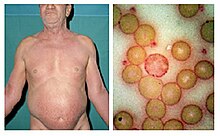Sézary disease
| Sézary disease | |
|---|---|
| Other names | Sézary's disease, Sézary('s) syndrome |
 | |
| The bright red rash of Sezary syndrome | |
| Pronunciation | |
| Specialty | Oncology, dermatology |
Sézary disease, or Sézary syndrome,
Signs and symptoms

Sézary disease and
- Generalized erythroderma – redness of the skin[3]
- Lymphadenopathy – swollen, enlarged lymph nodes[3]
- Atypical T cells – malignant lymphocytes known as "Sézary cells" seen in the peripheral blood with typical cerebriform nuclei (brain-shaped, convoluted nuclei)[8][3]
- Hepatosplenomegaly– enlarged liver and spleen[9]
- Palmoplantar keratoderma – thickening of the palms of the hands, and soles of the feet[10][11]
Diagnosis

Those who have Sézary disease often present skin lesions that do not heal with normal medication.[12] A blood test generally reveals any change in the levels of lymphocytes in the blood, which is often associated with a cutaneous T-cell lymphoma.[12] Finally, a biopsy of a skin lesion can be performed to rule out any other causes.[12]
The immunohistochemical features are very similar to those presented in mycosis fungoides except for the following differences:[13]
- More monotonous cellular infiltrates (large, clustered atypical pagetoid cells) in Sézary syndrome
- Sometimes absent epidermotropism
- Increased lymph node involvement with infiltrates of Sézary syndrome.
Treatment
Treatment typically includes some combination of
Treatments are often used in combination with
Radiation therapy
A number of types of radiation therapy may be used including
Chemotherapy
Romidepsin, vorinostat and a few others are a second-line drug for cutaneous T-cell lymphoma.[17] Mogamulizumab has been approved in Japan[18] and the United States.[19]
Epidemiology
In the Western population, there are around 3 cases of Sézary syndrome per 1,000,000 people.[3] Sézary disease is more common in males with a ratio of 2:1,[3] and the mean age of diagnosis is between 55 and 60 years of age.[3][9]
See also
- List of cutaneous conditions
References
- ^ Reference, Genetics Home. "Sézary syndrome". Genetics Home Reference.
- Who Named It?
- ^ a b c d e f g h i j k Cuneo, A; Castoldi, GL (2005). "Mycosis fungoidses/Sezary's syndrome". Atlas Genet Cytogenet Oncol Haematol. 9 (3): 242–243. Retrieved 2008-02-15.
- PMID 9129044.
- ISBN 978-1-4051-1376-2.
- ISBN 978-3-319-14728-4.
- ^ "Sezary syndrome". genetic and rare diseases information center. Retrieved 17 April 2018.
- PMID 28096719.
- ^ a b Lorincz, A. I. "Sezary syndrome". Retrieved 2008-02-15.
- PMID 29026585.
- S2CID 44779503.
- ^ a b c "Diagnosis". Retrieved 2008-02-15.
- )
- ^ "Mycosis Fungoides (Including Sézary Syndrome) Treatment". National Cancer Institute. 7 September 2017. Retrieved 1 December 2017.
- ISBN 978-1-4051-1376-2.
- ^ a b c "Mycosis Fungoides (Including Sézary Syndrome) Treatment". National Cancer Institute. 12 July 2017. Retrieved 1 December 2017.
- PMID 24438970.
- PMID 22686619.
- ^ "FDA approves mogamulizumab-kpkc for mycosis fungoides or Sézary syndrome". U.S. Food and Drug Administration. 2018-08-08. Retrieved 2020-08-04.
